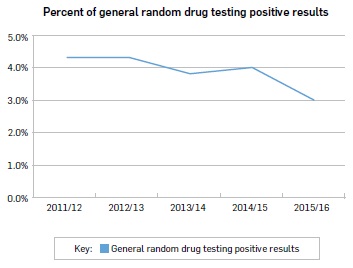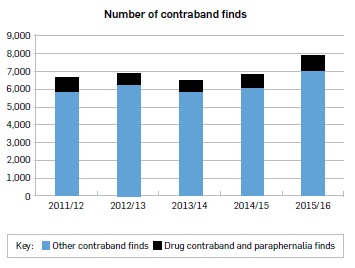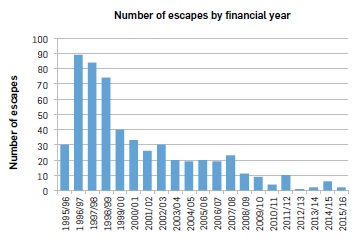Integrity of prison sentences
The integrity of sentences is maintained when Corrections’ facilities have minimal internal crime (such as the introduction of contraband) and few escapes.
Preventing prisoner access to drugs
The stability, safety and security of prisons is improved by controlling or limiting the availability of contraband, particularly drugs.
From July 2015 all prison sites have developed contraband detection plans, which aim to identify and address key issues surrounding detection and prevention within the prison system. The plans have also been shared between prison sites, to enable learning and replication of best practice across the network. These plans have seen significant engagement and commitment from key personnel at prison sites, and are instrumental in our ongoing work to improve security and integrity across the prison network.
As well as being illegal, drug use undermines the safety, security and good order of prisons. Corrections places considerable emphasis on reducing the supply and demand for drugs in prisons.
Searches of prisoners, their property and the places where they work, sleep and congregate are an important part of our contraband prevention strategy.
Staff work constantly to identify and mitigate risk areas in a prison’s physical environment, and to stay informed about new methods of concealment. In recent years, Corrections has introduced clear-case rental televisions for prisoners, which cannot be used to introduce or hide contraband. The Department has 15 drug detection dog teams who efficiently and effectively disrupt the supply of drugs and other criminal activity.
As illustrated in the graphs to the right, this additional investment has resulted in higher contraband finds year on year and a continued decrease in positive general random drug tests over the same period.
Factors affecting contraband volumes include prisoner numbers, the volumes of new arrivals and transits from courts, the profile of the prisoners and their visitors, and the design and layout of the prison and grounds. For example, some prison perimeter fences are close to public roads, and prisoners may attempt to receive “throw-overs” of contraband from outside.


The percent of prisoners testing positive in general random drug tests continues to decline, reaching an all-time low of 3.4% in 2015/16, down from 4.0% in 2014/15. In comparison, the rate of positive results in 2009/10 was 10% and in 2000/01 it was around 22%. The 2015/16 result is particularly impressive, considering that the prison population has doubled since 1995.
If prisons are clear of drugs and prisoners are close to home, prisoners are less likely to abscond or escape
For the past two financial years there have been no physical breakout escapes from prisons, which is a reflection of our long term, successful investment in security and the management of offenders in prison.
Prisoner transits are one of the most common situations in which prisoners find opportunities to escape. Transits require prisoners to be temporarily outside the prison and, unlike Release to Work or rehabilitation programmes, prisoners involved in transits cannot always be screened or excluded based on their level of risk.
On average there are more than 82,000 prisoner movements each year, and just over half of these are between prisons and courts. Each movement requires a secure escort provided either by Corrections or a contracted security provider, and Corrections currently maintains a fleet of over 100 vehicles for this purpose.
Corrections continues to utilise Audio Visual Link (AVL) technology as a means to reduce the need for transits and escorts. This can significantly reduce the risk of prisoners attempting to escape, and also reduces opportunities for acquiring contraband or becoming violent during transport.
In this financial year there have been two escapes from Corrections’ custody. One of these was from Auckland Region Women’s Corrections Facility, and the other from Christchurch Men’s Prison. Both occurred while the prisoner was being escorted.
Breakdown of escapes 2011/12 - 2015/16
| Financial Year | From Escort | Breach of temporary release | Abscond | Breakout |
|---|---|---|---|---|
| 2011/12 | 5 | 0 | 2 | 3 |
| 2012/13 | 1 | 0 | 0 | 0 |
| 2013/14 | 1 | 0 | 0 | 1 |
| 2014/15 | 4 | 1 | 1 | 0 |
| 2015/16 | 2 | 0 | 0 | 0 |

The graph shows the total number of escapes since the formation of the Department as an agency in 1995. The total escapes include breakout, abscond, breach of temporary release and escape from escort.

